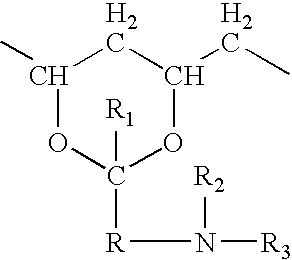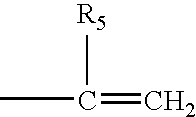Hydrogel spinal disc implants with swellable articles
a technology of spinal disc and swelling article, which is applied in the field of hydrogel spinal disc implants with swelling articles, can solve the problems of disc to lose a small amount of water to the surrounding environment, annulus fibrosis to change, and additional stress on the fibers, and achieve the effect of lifting and water uptak
- Summary
- Abstract
- Description
- Claims
- Application Information
AI Technical Summary
Benefits of technology
Problems solved by technology
Method used
Image
Examples
example 1
Yield Load Experiments
[0102] Hydrogels were made and tested for their yield load with and without the inclusion of PVA based microspheres. The mechanical testing was conducted by compressing the hydrogel specimens to failure between parallel stainless steel anvils using a Bionix 858 testing machine (MTS Systems Corp., Eden Prairie, Minn.). The specimens were unconstrained laterally. The fixtures were immersed in a phosphate buffered 0.9% saline test bath at 37±1° C. Each specimen was subjected to three conditioning cycles to a nominal strain of 20%. The loading and unloading rate was at 5 mm / min. The time, displacement, and force data were recorded at 10 Hz.
[0103] The PVA was Mowiol 3-83 (14 k MW) (from Hoechst Cleanese / Gehring Montgomery). The crosslinker was NAAADA (N-acrylamido acetaldehyde dimethyl acetal) at 15 crosslinkers per chain. Hydrophobic modification of the macromer was accomplished using AADA (acetaldehyde diethyl acetal). Hydrophilic modification of the macromer wa...
example 2
Lifting Experiments
[0107] Hydrogels containing various amounts of PVA based microspheres were made and tested for their lifting capacity. The hydrogels were cured and stored in saline overnight at 37° C. The lifting capacity was then determined by measuring the change in height, weight, and diameter.
[0108] The PVA was Mowiol 3-83 (14 k MW). The crosslinker was NAAADA (N-acrylamido acetaldehyde dimethyl acetal) at 15 crosslinkers per chain. Hydrophobic modification of the macromer was accomplished using AADA (acetaldehyde diethyl acetal) at 2.7 milliequivalents. The comonomer DAA (diacetone acrylamide) was included in a 1:1 ratio. The initiator was ammonium persulfate (0.5%) and the accelerator was TMEDA (0.3%). Dehydrated PVA-based microspheres were included, made generally as described in WO 01 / 68720. The amount of microspheres ranged from 5% percent to 10% by weight. Two types of microspheres were used in the swelling experiments. The microspheres designated as 7-1 contained 1% ...
example 3
Effect of Microspheres Addition in Formulations
[0109] The PVA was Mowiol 3-83 (14 k MW). The crosslinker was NAAADA (N-acrylamido acetaldehyde dimethyl acetal) at 15 crosslinkers per chain. Hydrophobic modification of the macromer was accomplished using AADA (acetaldehyde diethyl acetal) at 2.7 milliequivalents. The comonomer DAA (diacetone acrylamide) was included in a 1 to 1 ratio. 0.25% APS was dissolved in the formulation by stirring for 1 min. 0.3% TMEDA was added to the formulation and stirred for 15 sec. The dry microspheres were added and mixed for 20 sec. The formulation was poured into molds and allowed to cure for 10 min. Polymers were demolded, weighed, and their height and diameter measured. The polymers were then stored in 50 ml saline and placed in a 37° C. oven for the time indicated.
T = 0T = 24 hrT = 72 hrs% Increase afterWtHtDWtHtDWtHtD72 hrs% ms(g)(mm)(mm)(g)(mm)(mm)(g)(mm)(mm)WtHtD22.8947.9921.463.0658.3021.983.0248.1521.904.492.002.0542.8797.8721.253.0698.362...
PUM
 Login to View More
Login to View More Abstract
Description
Claims
Application Information
 Login to View More
Login to View More - R&D
- Intellectual Property
- Life Sciences
- Materials
- Tech Scout
- Unparalleled Data Quality
- Higher Quality Content
- 60% Fewer Hallucinations
Browse by: Latest US Patents, China's latest patents, Technical Efficacy Thesaurus, Application Domain, Technology Topic, Popular Technical Reports.
© 2025 PatSnap. All rights reserved.Legal|Privacy policy|Modern Slavery Act Transparency Statement|Sitemap|About US| Contact US: help@patsnap.com



